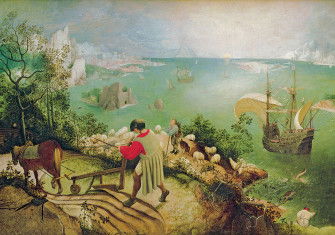
The Ascension
A master of the early Renaissance depicts the moment that Christians regard as the confirmation of Jesus’ divinity.
Forty days after his resurrection, Christ, shrouded in clouds, ascends to Heaven. The climactic event of his time on Earth is witnessed by 11 of his 12 Disciples: Judas Iscariot, who betrayed Christ for 30 pieces of silver, had hanged himself in shame. Various accounts claim that St Paul the Apostle was also present, as well as the Virgin Mary, depicted by Giotto in blue, an expensive pigment worthy of the Mother of God. Christ is accompanied on his ascent by two angels who, according to the New Testament Book of Acts, promise that: ‘This same Jesus, who was taken up from you into Heaven, will so come in like manner as you saw Him go into Heaven.’
In an extraordinarily concise passage, St Mark’s Gospel summarises the Ascension in two sentences: ‘So then, after the Lord had spoken to them, He was received up into Heaven, and sat down at the right hand of God. And they went out and preached elsewhere.’ Christ’s return to Heaven was the ultimate symbol of his divinity.
Giotto’s delicate fresco, part of a cycle, in the Scrovegni Chapel in Padua portrays Christ in profile, as if climbing. The painter, arguably the most significant artist of the early Renaissance, may have been influenced by a verse in medieval Ascension liturgies: ‘The Lord leads captivity captive, climbing on high to his holy place on Sinai.’ Christ’s hands pierce the frame of the image, a device employed for centuries in iconography. Artists within the orbit of Venice were often influenced by such Byzantine traditions.





